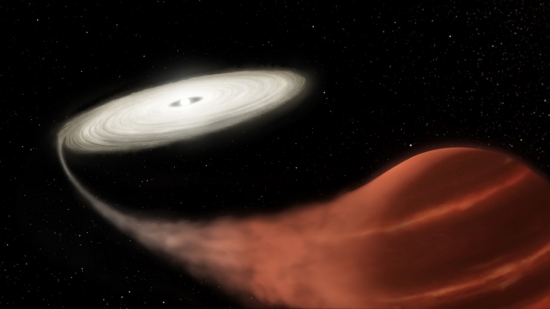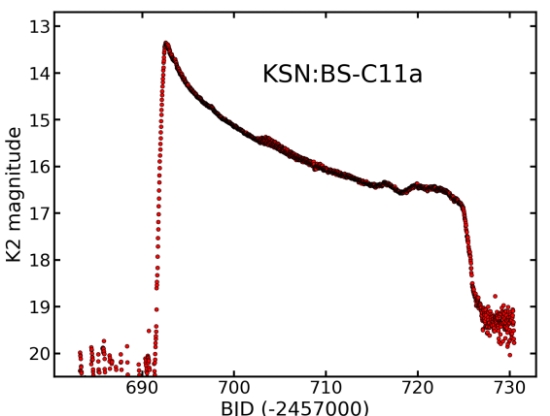Cataclysmic variable stars (CVs) are binary phenomena, usually consisting of a white dwarf that is accreting material out of a nearby companion star. As you would imagine, a wide range of CVs in various stages of accretion and subsequent outburst can be detected. When the accretion disk around the white dwarf becomes unstable, we get what is known as a dwarf nova (DN), and in systems with orbital periods less than two hours, there can be much more violent outbursts, feeding off orbital resonances in the orbit of the two stars.
Now we have a newly discovered cataclysmic variable (KSN:BS-C11a) in an interesting configuration, a white dwarf apparently feeding off a brown dwarf companion that is about 10 times less massive. The ‘super-outburst’ from the dwarf nova turned up in data from the decommissioned Kepler Space Telescope. Grad student Ryan Ridden-Harper (Australian National Observatory), lead author of the paper on this work, likes to refer to this cataclysmic variable as ‘a vampire star system.’ Whatever we call it, the level of activity here is noteworthy:
“The incredible data from Kepler reveals a 30-day period during which the dwarf nova rapidly became 1,600 times brighter before dimming quickly and gradually returning to its normal brightness. The spike in brightness was caused by material stripped from the brown dwarf that’s being coiled around the white dwarf in a disk. That disk reached up to 11,700 degrees Celsius at the peak of the super-outburst.”

Image: An artist’s impression of a star ‘feeding’ off a nearby brown dwarf. Credit: NASA and L. Hustak (STScI)
Still unexplained is the slow rise in brightness that preceded the outburst. Ridden-Harper has been working with colleagues at ANU as well as the Space Telescope Science Institute (STScI) and the University of Notre Dame. What catches my eye about the discovery of this bright transient is the data mining that turned it up. The team had been searching for new transients in the K2 and Kepler campaigns in a project known as K2: Background Survey. The idea here is that each science target in the data is accompanied by background pixels that have been observed at high cadence, meaning a short time period before re-observing the same target.
These background pixels, the authors note, can contain transient signals that have thus far gone undetected. The paper describes the K2: Background Survey as:
…a systematic search for transients in K2/Kepler background pixels. K2:BS independently analyses each pixel to detect abnormal behaviour. This is done by searching for pixels that rise above a brightness threshold set from the median brightness and standard deviation through a campaign. Telescope motion presents a challenge in candidate detection as science targets may drift into background pixel, triggering false events. False triggers are screened by vetting of events that last < 1 day, chosen for candidates with the 6 hourly telescope resets. Coincident pixels that pass the vetting procedure are grouped into an event mask. All candidate events are checked against the NASA/IPAC Extragalactic Database (NED) 1 and the SIMBAD database (Wenger et al. 2000) to identify potential hosts.
As to the parameters of the system, the brown dwarf orbits the white dwarf every 83 minutes at a distance of approximately 400,000 kilometers, close enough to allow the rapid growth of the accretion disk as material spirals from the brown dwarf inward toward the host star. The Kepler cadence of 30 minutes turns out to have been the key to making these observations, which are particularly useful because only about 100 such dwarf novae systems have been catalogued.

Image: This is Figure 3 from the paper. Caption: The K2/Kepler light curve of the transient KSN:BS-C11a shown with the 30-minute cadence. The time axis is shown in barycentric Julian days and the flux has been converted to Kepler magnitudes. Credit: Ridden-Harper et al.
Thus Kepler/K2 keeps on producing good science, in this case finding a transient whose rarity stems partially from the years or decades such a system can spend between outbursts. We shouldn’t be too surprised that Kepler data can produce such results — after all, the telescope was designed to study the transits of planets across the face of a star, making it ideal for spotting any objects that brighten or dim over time — but now we can see the potential for detecting other rare transient events both in archival data and data from ongoing missions like TESS.
The paper is Harper et al., “Discovery of a new WZ Sagittae-type cataclysmic variable in the Kepler/K2 data,” Monthly Notices of the Royal Astronomical Society,” Vol. 490, Issue 4 pp. 5551-5559 (abstract).



If a white dwarf can strip material from a smaller[?] brown dwarf, does this mean that there could be CVs using hot Jupiters, or even Neptunes, as material sources?
I wouldn’t be surprised given the scale of the system. These bodies are the same distance apart as Earth is from Moon. The WD is relatively compact but the BD, Jovian or even Neptune sized body has a large diameter — a substantial fraction of the distance to the WD — and is largely gaseous so this style of interaction is inevitable considering the tidal forces.
I would think so, but in any such system the planet would have had to have survived the star’s giant phase prior its becoming a WD. Possible, but maybe rare compared to star-WD pairings.
Hot Jupiters, orbiting so close to their sun would likely be swallowed up as the star becomes a red giant. A “warm” planet however could be at the right distance to receive mass from the star and then give some back once the star collapses down into a WD.
I know every dwarf nova is a classical nova, which at long intervals not only has big flares from gas falling on it, but huge eruptions from hydrogen fusion on the WD.
But are all classical novae dwarf novae, or do some accrete gas evenly so they burn evenly until they erupt?
Yes a white dwarf can strip material of hot Jupiters and Neptunes because the mass of the white dwarf is so much greater it can even strip material off of a red dwarf star if is in a close enough orbit to the white dwarf. https://centauri-dreams.org/2016/07/29/an-unusual-pulsating-binary/
Perhaps “they” may model profiles for a variety of phenomena including some that could suggest alien intelligence, and automate them to routinely run as many of them as possible on every sky survey dataset… looking to find more needles in the haystacks.
The Roche lobe in the illustration seems too narrow and orderly … while it’s not the same thing, I’m wondering if the messiness of a system like https://www.subarutelescope.org/Pressrelease/2009/11/19/index.html might apply here.
At a remote 900 parsecs, this pair cannot have their individual masses determined . But an accurate mass ratio is given as 0.07. So the white dwarf primary would have to have a minimum mass of about 1.35Msun for its L class brown dwarf to provide sufficient mass to initiate a type 1 supernova. Though even this would be unlikely as it wouldn’t account for evolutionary mass loss via conversion to energy in novae. This would push the theoretical mass required by the primary even nearer to the 1.44 Chandraskhar limit of a none rotating WD. Touch and go.
On a related and provocative note, I’ve often wondered about two hypothetical brown dwarfs in a similar orbit to that described here. One large, the other much smaller. The “primary” with a mass near but below the maximum upper limit for such bodies , say 70Mjup. Could enough mass be acquired via accretion from a smaller companion ( is there an optimal mass for this ?) for the larger brown dwarf to commence persistent hydrogen fusion at its core ? So initiating entry onto the main sequence as a star.
Same process but almost the reverse of a type 1 supernova .
This might be a silly question but is there an estimate for how long it would take the WD to “eat” the entire brown dwarf? Would this be a process lasting millions or tens of millions of years for example?
Hi Ashley,
Forgot where I read this, but I recall reading that what you propose was given as a possible explanation for some unusual object. Sorry I can’t be more specific.
David
I am going to make an intuitive guess to answer your question Ashley Baldwin. Most likely a large mass brown dwarf would not have enough gravity to pull large amounts of gas off of the smaller one like the white dwarf and and brown dwarf in this thread. The reason being a one solar mass and white dwarf is much larger and denser than a M dwarf and very much larger than a brown dwarf. The gravity of the white dwarf is also stronger.
It still would be interesting to see what would happen if two large brown dwarfs collided. Would there be a new body with the mass to have a high enough core temperature for fusion to begin and make an M dwarf star or would the collision result in two or several small bodies with a lot of lost gas and debris into space? The latter outcome is probably the case. The two brown dwarfs would have to collide for their to be any changes though or be really close which would not result in much exchange of gas from the smaller body to the larger.
In theory a white dwarf which was massive enough might be pushed past the Chandraskhar limit to become a super nova, but it would require a lot or most of the gas of the brown dwarf which might take a long time or not be possible. A collision between these two bodies might also make a supernova, but such a collision might also not produce a supernova, but a lot of debris and gas might be left over to orbit around the white dwarf due to the colossal kinetic energy and momentum of the collision probably overcoming the gravitational attraction of the more dense body . The gas and mass slowly accumulates in the white dwarf before it becomes a type one a supernova.
Although dwarf novas like the one in this article are bright, they are a very long way from the temperature and brightness found in a type one A supernova.